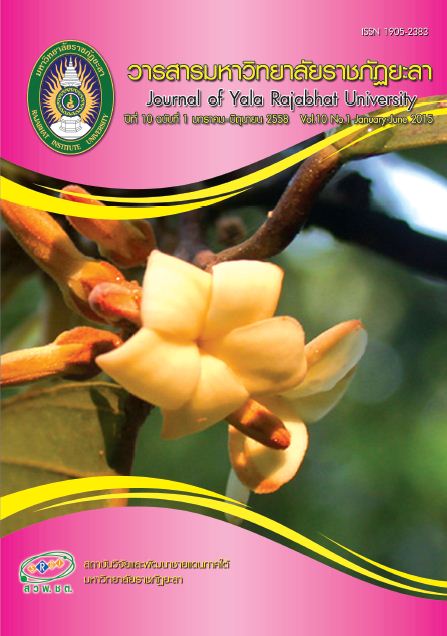Effect of Heptachlor and Endosulfan Sulfate-Contaminated Soil on Cucurbitaceae and Brassicaceae Plants Growth
Main Article Content
Abstract
The effect of heptachlor and endosulfan sulfate co-contaminated soil on seedling growth of Cucurbitaceae and Brassicaceae plants. Heptachlor and endosulfan sulfate were spiked into soil as ratio 1:1 at total concentration ranging from 0.4-4 mg/kg dried soil. Three plants, Brassica pekinensis, Cucurbita moschata and cucumber were planted in spiked soil compared with non contaminated soil. After 10 days, percentage of germination, shoot and root length, fresh and dry weight of seedling were measured. The result shown that heptachlor and endosulfan sulfate co-contaminated soil (ratio 1:1) were not toxic to germination of all plant but the effect on shoot and root length depended on plant species. Shoot length of C. moschataand cucumber were decreased when concentrations of contaminants were higher but shoot length of B. pekinensis was not significantly different. For the effect on root length, root length of C. moschata was not significantly different with contrast with root length of cucumber and B. pekinensis. The contaminants did not affect to fresh and dry weight of all plant which shown that there were no effect on these plant growth. All plants tested in this experiment could grow in soil contaminated with heptachlor and endosulfan sulfate at this concentration.
Article Details
Copyright Notice articles, information, images, etc. was published in this Journal of Yala Rajabhat University is a copyright of the journal Yala Rajabhat University. If any person or deparment wants to bring all or part of it for publish or take any action. Authorization is required in written form from the Journal of Yala Rajabhat University only.
References
2.ขนิษฐา สมตระกูล และสุนันทา ประทุมมา. (2554ข). ความเป็นพิษของเอ็นโดซัลแฟน-ซัลเฟตที่ปนเปื้อนในดินต่อการเจริญของพืชเศรษฐกิจในระยะต้นกล้า. แก่นเกษตร, 39, 295-299.
3.ปิยะวรรณ ศรีวิลาศ และกานดา ใจดี. (2549). สารฆ่าแมลงกลุ่มออร์กาโนคลอรีนในดินตะกอนบริเวณชายฝั่งทะเลภาคตะวันออกของประเทศไทย. ว. วิทยาศาสตร์ บูรพา, 11, 26-39.
4.วราภรณ์ ฉุยฉาย เจริญพงษ์ ชมพูนุช สุชาติ สระทองหน และปัทมาพร รูปปัทม์. (2553).ความเป็นพิษของลินเดนและเอนโดซัลแฟนที่ตกค้างในดินด่างต่อการเจริญระยะต้นกล้า
ของถั่วฝักยาวและผักกวางตุ้ง. รายงานการประชุมวิชาการเกษตรครั้งที่ 11(หน้า 425-428), 25-25 มกราคม 2553. ขอนแก่น: มหาวิทยาลัยขอนแก่น.
5.Ajithkumar, P. U., Gangadhar, K. P., Manilal P. and Kunhi, A. A. M. (1998). Soil inoculation with Pseudomonas aeruginosa 3MT eliminates the inhibitory effect of 3-chloro- and 4-chlorobenzoate on tomato seed germination. Soil Biol. Biochem, 30, 1053-1059.
6.Calveno Pereira, R. C., Monterroso, C. and Macías, F. (2010). Phytotoxicity of hexachlorocyclohexane: Effect on germination and early growth of different plant species. Chemosphere, 79, 326-333.
7.Chouychai, W. and Lee, H. (2012). Phytotoxicity assay of crop plants to lindane and alpha-endosulfan contaminants in alkaline Thai soil. Int. J. Agri. Biol, 14, 734 - 738.
8.Eom, I. C., Rast, C., Veber, A. M. and Vasseur, P. (2007). Ecotoxicology of a polycyclic aromatic hydrocarbon-contaminated soil. Ecotoxicol. Environ. Safe, 67, 190-205.
9.Gissel-Nielsen, G. and Nielsen, T. (1996). Phytotoxicity of acridine, an important representative of a group of tar and creosote contaminants, N-PAC compounds. Polycyclic Aromatic Compounds, 8, 243–249.
10.Otani, T. and Seike, N. (2007). Rootstock control of fruit dieldrin concentration in grafted cucumber (Cucurmis sativus). J. Pesticide Sci, 32, 235-242.
11.Poolpak, T., Pokethitiyook, P., Krautrachue, M., Arjarasirikoon, U. and Thanwaniwat, N. (2008). Residues analysis of orgaochlorine pesticides in the Mae Klong river of central Thailand. J. Hazard. Mat, 156, 230-239.
12.Sverdrup, L. E., Krogh, P. H., Nielsen, T., Kjaer, C. and Stenessen, J. (2003). Toxicity of eight polycyclic aromatic hydrocarbons to red clover (Trifolium pretense)
ryegrass (Lolium perenne) and mustard (Sinapsis alba). Chemosphere, 53, 993-1003.
13.Sverdrup, L. E., Hagen, S. B., Krogh, P. H. and van Gestel, C. A. M. (2007). Benzo[a] pyrene shows low toxicity to three species of terrestrial plants, two soil
invertebrates, and soil-nitrifying bacteria. Ecotoxicol. Environ. Safe, 66, 362-368.
14.Thapinta, A. and Hudak, P.F. (2003). Use of geographic information systems for assessing groundwater pollution potential by pesticides in central Thailand. Environ. Int, 29, 87-93.
15.Whitefield-Åslund, M. L. W., Lunney, A. L., Rutterand, A. and Zeeb, B. A. (2010). Effects of amendments on the uptake and distribution of DDT in Cucurbita pepo spp. pepo plants. Environ. Pollut, 158, 508-513.

